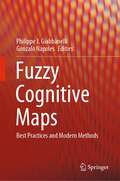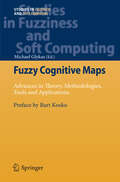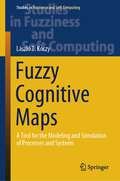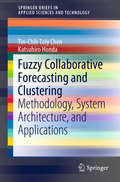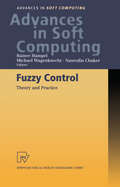- Table View
- List View
Fuzzy Choice Functions: A Revealed Preference Approach (Studies in Fuzziness and Soft Computing #214)
by Irina GeorgescuThis book extends the theory of revealed preference to fuzzy choice functions, providing applications to multicriteria decision making problems. The main topics of revealed preference theory are treated in the framework of fuzzy choice functions. New topics, such as the degree of dominance and similarity of vague choices, are developed. The results are applied to economic problems where partial information and human subjectivity involve vague choices and vague preferences.
Fuzzy Classification of Online Customers (Fuzzy Management Methods)
by Nicolas WerroThis book introduces a fuzzy classification approach, which combines relational databases with fuzzy logic for more effective and powerful customer relationship management (CRM). It shows the benefits of a fuzzy classification in contrast to the traditional sharp evaluation of customers for the acquisition, retention and recovery of customers in online shops. The book starts with a presentation of the basic concepts, fuzzy set theory and the combination of relational databases and fuzzy classification. In its second part, it focuses on the customer perspective, detailing the central concepts of CRM, its theoretical constructs and aspects of analytical, operational and collaborative CRM. It juxtaposes fuzzy and sharp customer classes and shows the implications for customer positioning, mass customization, personalization, customer assessment and controlling. Finally, the book presents the application and implementation of the concepts in online shops. A detailed case study presents the application and a separate chapter introduces the fuzzy Classification Query Language (fCQL) toolkit for implementing these concepts. In its appendix the book lists the fuzzy set operators and the query language’s grammar.
Fuzzy Classifier Design (Studies in Fuzziness and Soft Computing #49)
by Ludmila I. KunchevaFuzzy sets were first proposed by Lotfi Zadeh in his seminal paper [366] in 1965, and ever since have been a center of many discussions, fervently admired and condemned. Both proponents and opponents consider the argu ments pointless because none of them would step back from their territory. And stiH, discussions burst out from a single sparkle like a conference pa per or a message on some fuzzy-mail newsgroup. Here is an excerpt from an e-mail messagepostedin1993tofuzzy-mail@vexpert. dbai. twvien. ac. at. by somebody who signed "Dave". , . . . Why then the "logic" in "fuzzy logic"? I don't think anyone has successfully used fuzzy sets for logical inference, nor do I think anyone wiH. In my admittedly neophyte opinion, "fuzzy logic" is a misnomer, an oxymoron. (1 would be delighted to be proven wrong on that. ) . . . I carne to the fuzzy literature with an open mind (and open wal let), high hopes and keen interest. I am very much disiHusioned with "fuzzy" per se, but I did happen across some extremely interesting things along the way. " Dave, thanks for the nice quote! Enthusiastic on the surface, are not many of us suspicious deep down? In some books and journals the word fuzzy is religiously avoided: fuzzy set theory is viewed as a second-hand cheap trick whose aim is nothing else but to devalue good classical theories and open up the way to lazy ignorants and newcomers.
Fuzzy Cognitive Maps: Best Practices and Modern Methods
by Philippe J. Giabbanelli Gonzalo NápolesThis book starts with the rationale for creating an FCM by contrast to other techniques for participatory modeling, as this rationale is a key element to justify the adoption of techniques in a research paper. Fuzzy cognitive mapping is an active research field with over 20,000 publications devoted to externalizing the qualitative perspectives or “mental models” of individuals and groups. Since the emergence of fuzzy cognitive maps (FCMs) back in the 80s, new algorithms have been developed to reduce bias, facilitate the externalization process, or efficiently utilize quantitative data via machine learning. It covers the development of an FCM with participants through a traditional in-person setting, drawing from the experience of practitioners and highlighting solutions to commonly encountered challenges. The book continues with introducing principles of simulations with FCMs as a tool to perform what-if scenario analysis, while extending those principles to more elaborated simulation scenarios where FCMs and agent-based modeling are combined. Once an FCM model is obtained, the book then details the analytical tools available for practitioners (e.g., to identify the most important factors) and provides examples to aid in the interpretation of results. The discussion concerning relevant extensions is equally pertinent, which are devoted to increasing the expressiveness of the FCM formalism in problems involving uncertainty. The last four chapters focus on building FCM models from historical data. These models are typically needed when facing multi-output prediction or pattern classification problems. In that regard, the book smoothly guides the reader from simple approaches to more elaborated algorithms, symbolizing the noticeable progress of this field in the last 35 years. Problems, recent references, and functional codes are included in each chapter to provide practice and support further learning from practitioners and researchers.
Fuzzy Cognitive Maps: Advances in Theory, Methodologies, Tools and Applications (Studies in Fuzziness and Soft Computing #247)
by Michael GlykasThis important edited volume is the first such book ever published on fuzzy cognitive maps (FCMs). Professor Michael Glykas has done an exceptional job in bringing together and editing its seventeen chapters. The volume appears nearly a quarter century after my original article “Fuzzy Cognitive Maps” appeared in the International Journal of Man-Machine Studies in 1986. The volume accordingly reflects many years of research effort in the development of FCM theory and applications—and portends many more decades of FCM research and applications to come. FCMs are fuzzy feedback models of causality. They combine aspects of fuzzy logic, neural networks, semantic networks, expert systems, and nonlinear dynamical systems. That rich structure endows FCMs with their own complexity and lets them apply to a wide range of problems in engineering and in the soft and hard sciences. Their partial edge connections allow a user to directly represent causality as a matter of degree and to learn new edge strengths from training data. Their directed graph structure allows forward or what-if inferencing. FCM cycles or feedback paths allow for complex nonlinear dynamics. Control of FCM nonlinear dynamics can in many cases let the user encode and decode concept patterns as fixed-point attractors or limit cycles or perhaps as more exotic dynamical equilibria. These global equilibrium patterns are often “hidden” in the nonlinear dynamics. The user will not likely see these global patterns by simply inspecting the local causal edges or nodes of large FCMs.
Fuzzy Cognitive Maps: A Tool for the Modeling and Simulation of Processes and Systems (Studies in Fuzziness and Soft Computing #427)
by László T. KóczyThis book is considered as a monograph but also as a potential textbook for graduate students, focusing on the application of FCMs for modelling and analysing the behaviour of multicomponent systems. In the last two decades, no monograph or textbook has been published on the topic Fuzzy Cognitive Maps (FCM), so this new book is definitely filling a gap in the literature of computational intelligence. The book is built up didactically, the novel results in the field being presented in the way of starting with two real-life case studies, one in the area of waste management, while the other one in modelling bank management systems. In both cases, the book starts with explaining the applied problem and then presenting how the model construction is done and what problems emerge when attempts are made for applying directly earlier results on FCM modelling. In the first case study, the problem of the oversimplification leads to inadequacy of the model, and then it is shown how new, much finer models can be built up based on expert domain knowledge. Then, the new problem of losing transparency and interpretability emerges, and as a solution, a new algorithm family is proposed that reduces FCMs to fewer components, while preserving the essential characteristics of the original model.The second case study raises the problems of stability and sensitivity of FCMs, especially, considering that expert knowledge is often uncertain and subjective. The new results summarised in the book target the questions of how to ascertain whether an FCM is converging to one or several fixed point attractors, whether there is a bifurcation when parameters are changing, etc. Both problems deal with the ultimate question whether the system modelled is stable and sustainable.
Fuzzy Cognitive Maps for Applied Sciences and Engineering: From Fundamentals to Extensions and Learning Algorithms (Intelligent Systems Reference Library #54)
by Elpiniki I. PapageorgiouFuzzy Cognitive Maps (FCM) constitute cognitive models in the form of fuzzy directed graphs consisting of two basic elements: the nodes, which basically correspond to “concepts” bearing different states of activation depending on the knowledge they represent, and the “edges” denoting the causal effects that each source node exercises on the receiving concept expressed through weights. Weights take values in the interval [-1,1], which denotes the positive, negative or neutral causal relationship between two concepts. An FCM can be typically obtained through linguistic terms, inherent to fuzzy systems, but with a structure similar to the neural networks, which facilitates data processing, and has capabilities for training and adaptation.During the last 10 years, an exponential growth of published papers in FCMs was followed showing great impact potential. Different FCM structures and learning schemes have been developed, while numerous studies report their use in many contexts with highly successful modeling results. The aim of this book is to fill the existing gap in the literature concerning fundamentals, models, extensions and learning algorithms for FCMs in knowledge engineering. It comprehensively covers the state-of-the-art FCM modeling and learning methods, with algorithms, codes and software tools, and provides a set of applications that demonstrate their various usages in applied sciences and engineering.
Fuzzy Collaborative Forecasting and Clustering: Methodology, System Architecture, and Applications (SpringerBriefs in Applied Sciences and Technology)
by Tin-Chih Toly Chen Katsuhiro HondaThis book introduces the basic concepts of fuzzy collaborative forecasting and clustering, including its methodology, system architecture, and applications. It demonstrates how dealing with disparate data sources is becoming more and more popular due to the increasing spread of internet applications. The book proposes the concepts of collaborative computing intelligence and collaborative fuzzy modeling, and establishes several so-called fuzzy collaborative systems. It shows how technical constraints, security issues, and privacy considerations often limit access to some sources. This book is a valuable source of information for postgraduates, researchers and fuzzy control system developers, as it presents a very effective fuzzy approach that can deal with disparate data sources, big data, and multiple expert decision making.
Fuzzy Computational Ontologies in Contexts: Formal Models of Knowledge Representation with Membership Degree and Typicality of Objects, and Their Applications
by Yi Cai Ching-man Au Yeung Ho-fung LeungKnowledge Representation plays an essential role in Semantic Web, in particular in automated information processing and communications among software agents. This book, entitled "Fuzzy Computational Ontologies in Contexts: Formal Models of Knowledge Representation with Membership Degree and Typicality, and Their Applications", discusses knowledge representation in Semantic Web. It introduces the relevant background knowledge, models of fuzzy ontologies, importance and priority of properties in concepts, and object typicality in fuzzy ontologies and context-aware ontologies.The book is intended for graduate students, engineers, and researchers in the field of artificial intelligence and computer science.Yi Cai is an Assistant Professor in School of Software Engineering, South China University of Technology, Guangzhou, China. Ching-man Au Yeung is a Senior Engineer in Hong Kong Applied Science and Technology Research Institute, Hong Kong, China. Ho-fung Leung is a Professor and the Chairman of Department of Computer Science and Engineering, The Chinese University of Hong Kong, Hong Kong, China.
Fuzzy Control: Theory and Practice (Advances in Intelligent and Soft Computing #6)
by Rainer Hampel Michael Wagenknecht Nasredin ChakerThe present edited volume is of special importance, and for various reasons. First of all, it is one of the most comprehensive and multifaceted coverage of broadly per ceived fuzzy control in the literature. The editors have succeeded to collect papers from leading scholars and researchers on various subjects related to the topic of the volume. What is relevant and original is that - as opposed to so many volumes on fuzzy control published by virtually all major publishing houses that are strongly technically oriented and covering a narrow spectrum of issues relevant to fuzzy con trol itself - the editors have adopted a more general and far sighted approach. Basically, the perspective assumed in the volume is that though fuzzy control has reached such a level of maturity and implementability that it has become a part of in dustrial practice, science and academic research still have a relevant role to play in this area. One should however take into account that by their very nature, the role of science and academic research is very peculiar and going beyond straightforward ap plications, ad hoc solutions, "quick and dirty" tools and techniques, etc. that are usu ally effective and efficient for solving practical problems. This does not mean that as pects of practical implementations should not be accounted for by scholars and re searchers.
Fuzzy Control: Fundamentals, Stability and Design of Fuzzy Controllers (Studies in Fuzziness and Soft Computing #200)
by Kai Michels Frank Klawonn Rudolf Kruse Andreas NürnbergerThis book provides a critical discussion of fuzzy controllers from the perspective of classical control theory. Special emphasis is placed on topics of importance for industrial applications, including self-tuning of fuzzy controllers, optimisation and stability analysis. The text begins with a detailed introduction to fuzzy systems and control theory, and guides the reader to a thorough understanding of up-to-date research results.
Fuzzy Control and Filter Design for Uncertain Fuzzy Systems (Lecture Notes in Control and Information Sciences #347)
by Wudhichai Assawinchaichote Sing Kiong Nguang Peng ShiFuzzy Control, Estimation and Diagnosis: Single and Interconnected Systems
by Magdi S. MahmoudThis textbook explains the principles of fuzzy systems in some depth together with information useful in realizing them within computational processes. The various algorithms and example problem solutions are a well-balanced and pertinent aid for research projects, laboratory work and graduate study. In addition to its worked examples, the book also uses end-of-chapter exercises as an instructional aid with a downloadable solutions manual available to instructors. The content of the book is developed and extended from material taught for four years in the author’s classes. The text provides a broad overview of fuzzy control, estimation and fault diagnosis. It ranges over various classes of target system and modes of control and then turns to filtering, stabilization, and fault detection and diagnosis. Applications, simulation tools and an appendix on algebraic inequalities complete a unified approach to the analysis of single and interconnected fuzzy systems. Fuzzy Control, Estimation and Fault Detection is a guide for final-year undergraduate and graduate students of electrical and mechanical engineering, computer science and information technology, and will also be instructive for professionals in the information technology sector.
Fuzzy Control in Environmental Engineering (Studies in Systems, Decision and Control #31)
by Wojciech Z. ChmielowskiThis book is intended for engineers, technicians and people who plan to use fuzzy control in more or less developed and advanced control systems for manufacturing processes, or directly for executive equipment. Assuming that the reader possesses elementary knowledge regarding fuzzy sets and fuzzy control, by way of a reminder, the first parts of the book contain a reminder of the theoretical foundations as well as a description of the tools to be found in the Matlab/Simulink environment in the form of a toolbox.The major part of the book presents applications for fuzzy controllers in control systems for various manufacturing and engineering processes. It presents seven processes and problems which have been programmed using fuzzy controllers. The issues discussed concern the field of Environmental Engineering. Examples are the control of a flood wave passing through a hypothetical, and then the real Dobczyce reservoir in the Raba River, which is located in the upper Vistula River basin in Southern Poland, the control and water management in a cascade of reservoirs, a broadly defined combustion process model, modern water heating systems and many other.
Fuzzy Control of Queuing Systems
by Runtong Zhang Yannis A. Phillis Vassilis S. KouikoglouEvery day we experience the annoyance of having to queue. The phenomenon is becoming more prevalent in our increasingly congested and urbanised society. Not only the visible queues in traffic jams, airport check in desks and supermarkets, but the more common invisible queues caused by voice calls and data packets in optical and wireless channels. Queues cost us time, money and resources; so what is the solution to our greater demand for services than there are facilities? Queuing control plays a crucial role in manufacturing and communication networks around the world. This pioneering approach, using fuzzy control to solve queuing control problems, determines explicit solutions to various types of control in queuing systems. The bulk of results have been developed over the past decade and are presented here together for the first time. 21 detailed case studies demonstrate an efficient departure from classical techniques. Unique work creating a new Research and Development topic. Multidisciplinary approach that will benefit researchers and students throughout the fields of artificial intelligence, operations research, optimal control, Internet techniques, communications and traffic control industries. Equipped with an extensive bibliography for easy reference and scope for further study. Existing practical problems, especially those that are unresponsive to conventional control techniques, are solved with the introduction of this novel approach. A systematic framework of the ‘fuzzy control of queuing networks’ is developed through each individual case.
Fuzzy Control Systems with Time-Delay and Stochastic Perturbation: Analysis and Synthesis (Studies in Systems, Decision and Control #12)
by Ligang Wu Xiaojie Su Peng ShiThis book presents up-to-date research developments and novel methodologies on fuzzy control systems. It presents solutions to a series of problems with new approaches for the analysis and synthesis of fuzzy time-delay systems and fuzzy stochastic systems, including stability analysis and stabilization, dynamic output feedback control, robust filter design, and model approximation. A set of newly developed techniques such as fuzzy Lyapunov function approach, delay-partitioning, reciprocally convex, cone complementary linearization approach are presented. Fuzzy Control Systems with Time-Delay and Stochastic Perturbation: Analysis and Synthesis is a comprehensive reference for researcher and practitioners working in control engineering, system sciences and applied mathematics, and is also a useful source of information for senior undergraduates and graduates in these areas. The readers will benefit from some new concepts, new models and new methodologies with practical significance in control engineering and signal processing.
Fuzzy Cooperative Games: Cooperation with Vague Expectations (Studies in Fuzziness and Soft Computing #72)
by Milan MaresThe present book deals with coalition games in which expected pay-offs are only vaguely known. In fact, this idea about vagueness of expectations ap pears to be adequate to real situations in which the coalitional bargaining anticipates a proper realization of the game with a strategic behaviour of players. The vagueness being present in the expectations of profits is mod elled by means of the theory of fuzzy set and fuzzy quantities. The fuzziness of decision-making and strategic behaviour attracts the attention of mathematicians and its particular aspects are discussed in sev eral works. One can mention in this respect in particular the book "Fuzzy and Multiobjective Games for Conflict Resolution" by Ichiro Nishizaki and Masatoshi Sakawa (referred below as [43]) which has recently appeared in the series Studies in Fuzziness and Soft Computing published by Physica-Verlag in which the present book is also apperaing. That book, together with the one you carry in your hands, form in a certain sense a complementary pair. They present detailed views on two main aspects forming the core of game theory: strategic (mostly 2-person) games, and coalitional (or cooperative) games. As a pair they offer quite a wide overview of fuzzy set theoretical approaches to game theoretical models of human behaviour.
Fuzzy Data Warehousing for Performance Measurement: Concept and Implementation (Fuzzy Management Methods)
by Daniel FaselThe numeric values retrieved from a data warehouse may be difficult for business users to interpret, and may even be interpreted incorrectly. Therefore, in order to better understand numeric values, business users may require an interpretation in meaningful, non-numeric terms. However, if the transition between non-numeric terms is crisp, true values cannot be measured and a smooth transition between classes may no longer be possible. This book addresses this problem by presenting a fuzzy classification-based approach for a data warehouses. Moreover, it introduces a modeling approach for fuzzy data warehouses that makes it possible to integrate fuzzy linguistic variables in a meta-table structure. The essence of this structure is that fuzzy concepts can be integrated into the dimensions and facts of an existing classical data warehouse without affecting its core. This allows a simultaneous analysis, both fuzzy and crisp. A case study of a movie rental company underlines and exemplifies the proposed approach.
Fuzzy Database Modeling (Studies in Fuzziness and Soft Computing #26)
by Adnan Yazici Roy GeorgeSome recent fuzzy database modeling advances for the non-traditional applications are introduced in this book. The focus is on database models for modeling complex information and uncertainty at the conceptual, logical, physical design levels and from integrity constraints defined on the fuzzy relations. The database models addressed here are; the conceptual data models, including the ExIFO and ExIFO2 data models, the logical database models, including the extended NF2 database model, fuzzy object-oriented database model, and the fuzzy deductive object-oriented database model. Integrity constraints are defined on the fuzzy relations are also addressed. A continuing reason for the limited adoption of fuzzy database systems has been performance. There have been few efforts at defining physical structures that accomodate fuzzy information. A new access structure and data organization for fuzzy information is introduced in this book.
Fuzzy Database Modeling of Imprecise and Uncertain Engineering Information (Studies in Fuzziness and Soft Computing #195)
by Zongmin MaComputer-based information technologies have been extensively used to help industries manage their processes and information systems hereby - come their nervous center. More specially, databases are designed to s- port the data storage, processing, and retrieval activities related to data management in information systems. Database management systems p- vide efficient task support and database systems are the key to impleme- ing industrial data management. Industrial data management requires da- base technique support. Industrial applications, however, are typically data and knowledge intensive applications and have some unique character- tics that makes their management difficult. Besides, some new techniques such as Web, artificial intelligence, and etc. have been introduced into - dustrial applications. These unique characteristics and usage of new te- nologies have put many potential requirements on industrial data mana- ment, which challenge today’s database systems and promote their evolvement. Viewed from database technology, information modeling in databases can be identified at two levels: (conceptual) data modeling and (logical) database modeling. This results in conceptual (semantic) data model and logical database model. Generally a conceptual data model is designed and then the designed conceptual data model will be transformed into a chosen logical database schema. Database systems based on logical database model are used to build information systems for data mana- ment. Much attention has been directed at conceptual data modeling of - dustrial information systems. Product data models, for example, can be views as a class of semantic data models (i. e.
Fuzzy Database Modeling with XML (Advances in Database Systems #29)
by Zongmin MaFuzzy Database Modeling with XML aims to provide a single record of current research and practical applications in the fuzzy databases. This volume is the outgrowth of research the author has conducted in recent years. Fuzzy Database Modeling with XML introduces state-of-the-art information to the database research, while at the same time serving the information technology professional faced with a non-traditional application that defeats conventional approaches. The research on fuzzy conceptual models and fuzzy object-oriented databases is receiving increasing attention, in addition to fuzzy relational database models. With rapid advances in network and internet techniques as well, the databases have been applied under the environment of distributed information systems. It is essential in this case to integrate multiple fuzzy database systems. Since databases are commonly employed to store and manipulate XML data, additional requirements are necessary to model fuzzy information with XML. Secondly, this book maps fuzzy XML model to the fuzzy databases. Very few efforts at investigating these issues have thus far occurred. Fuzzy Database Modeling with XML is designed for a professional audience of researchers and practitioners in industry. This book is also suitable for graduate-level students in computer science.
Fuzzy Databases: Principles and Applications (International Series in Intelligent Technologies #5)
by Frederick E. PetryThis volume presents the results of approximately 15 years of work from researchers around the world on the use of fuzzy set theory to represent imprecision in databases. The maturity of the research in the discipline and the recent developments in commercial/industrial fuzzy databases provided an opportunity to produce this survey. In this introduction we will describe briefly how fuzzy databases fit into the overall design of database systems and then overview the organization of the text. FUZZY DATABASE LANDSCAPE The last five years have been witness to a revolution in the database research community. The dominant data models have changed and the consensus on what constitutes worthwhile research is in flux. Also, at this time, it is possible to gain a perspective on what has been accomplished in the area of fuzzy databases. Therefore, now is an opportune time to take stock of the past and establish a framework. A framework should assist in evaluating future research through a better understanding of the different aspects of imprecision that a database can model [ 1 l.
Fuzzy Discrete Structures (Studies in Fuzziness and Soft Computing #58)
by Davender S. Malik John N. MordesonThis ambitious exposition by Malik and Mordeson on the fuzzification of discrete structures not only supplies a solid basic text on this key topic, but also serves as a viable tool for learning basic fuzzy set concepts "from the ground up" due to its unusual lucidity of exposition. While the entire presentation of this book is in a completely traditional setting, with all propositions and theorems provided totally rigorous proofs, the readability of the presentation is not compromised in any way; in fact, the many ex cellently chosen examples illustrate the often tricky concepts the authors address. The book's specific topics - including fuzzy versions of decision trees, networks, graphs, automata, etc. - are so well presented, that it is clear that even those researchers not primarily interested in these topics will, after a cursory reading, choose to return to a more in-depth viewing of its pages. Naturally, when I come across such a well-written book, I not only think of how much better I could have written my co-authored monographs, but naturally, how this work, as distant as it seems to be from my own area of interest, could nevertheless connect with such. Before presenting the briefest of some ideas in this direction, let me state that my interest in fuzzy set theory (FST) has been, since about 1975, in connecting aspects of FST directly with corresponding probability concepts. One chief vehicle in carrying this out involves the concept of random sets.
Fuzzy Dual Numbers: Theory and Applications (Studies in Fuzziness and Soft Computing #359)
by Felix Mora-Camino Carlos Alberto Nunes CosenzaThis is the first book focusing exclusively on fuzzy dual numbers. In addition to offering a concise guide to their properties, operations and applications, it discusses some of their advantages with regard to classical fuzzy numbers, and describes the most important operations together with a set of interesting applications in e.g. optimization, decision-making and system design. The book provides students, researchers and professionals the necessary theoretical background to apply this particular subset of fuzzy numbers to decision-making problems involving uncertainty. Further, it shows how to solve selected engineering and management problems and includes detailed numerical examples.
Fuzzy Engineering and Operations Research (Advances in Intelligent and Soft Computing #147)
by Bing-Yuan Cao Xiang-Jun Xie“Fuzzy Engineering and Operations Research” is the edited outcome of the 5th International Conference on Fuzzy Information and Engineering (ICFIE2011) held during Oct. 15-17, 2011 in Chengdu, China and by the 1st academic conference in establishment of Guangdong Province Operations Research Society (GDORSC) held on Oct. 20, 2011 in Guangzhou, China. The 5th ICFIE2011, built on the success of previous conferences, and the GDORC, first held, are major Symposiums, respectively, for scientists, engineers practitioners and Operation Research (OR) researchers presenting their updated results, developments and applications in all areas of fuzzy information and engineering and OR. It aims to strengthen relations between industry research laboratories and universities, and to create a primary symposium for world scientists in Fuzziology and OR fields. The book contains 62 papers and is divided into five main parts: “Fuzzy Optimization, Logic and Information”, “The mathematical Theory of Fuzzy Systems”, “Fuzzy Engineering Applications and Soft Computing Methods”, “OR and Fuzziology” and “Guess and Review”.



